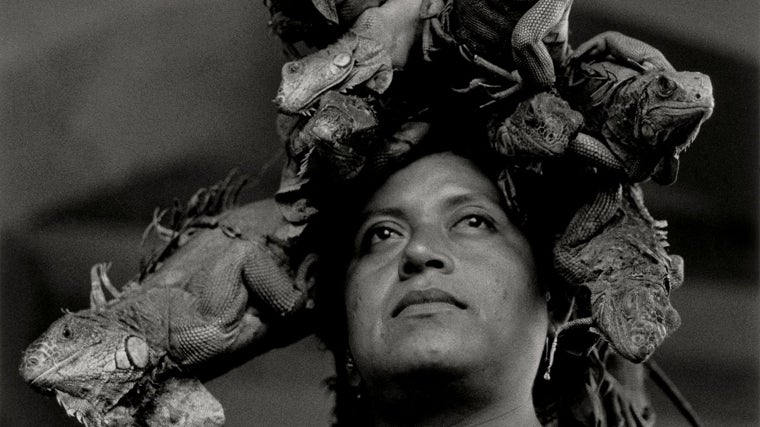Mexican photographer Graciela Iturbide, winner of the 2025 Princess of Asturias Award for the Arts
With this award, the Princess of Asturias Award for the Arts recognizes traditional black and white photography, including analog photography, the foundation and master of the digital avalanche that inundates us today. Both trends are still used by this artist, who confesses to maintaining the same curiosity she felt from the first day she photographed that little airplane (her first shot), which later gave rise to one of the most interesting voices in documentary photography in America.
The award jury highlighted in its report that Iturbide "has portrayed human nature through photographs charged with symbolism , which create a world of their own: from the primitive to the contemporary; from the harshness of social reality to the spontaneous magic of the moment."
Graciela Iturbide was born in 1942 in Mexico City to a very conservative family, whose father was against her university studies. This led the young Mexican woman to opt for the rhythms of the times: marry young and have children (she had to bury a daughter, the true mastery of pain in her photojournalism for someone who never saw herself prepared to be a war reporter), although, as she admits, she began studying film to free herself. Death, however, will be a constant in her image.
So, in 1969, she entered the University Center for Cinematographic Studies at the Autonomous University of Mexico. Even though she wanted to be a writer! And then Manuel Álvarez Bravo, "the good, bad influence," crossed her path, the divorced man (with all that meant at the time!), the old professor no one paid attention to because everyone wanted to direct films, not focus on still images.
But Graciela did. She did, and became his 'achichincle' (a beautiful word in Spanish from across the Atlantic for 'assistant' in her home country), with whom he learned, between 1970 and 1971, that other realities existed. And our protagonist opted for the solitude of the camera, putting film aside, with which she didn't feel comfortable because it required large groups: "Solitude allows you to find yourself more, it makes you more attentive to your surroundings," she admitted in an interview with ABC Cultural a few years ago, when she collected another award, the 5th Alcobendas International Photography Prize, the institution that organized her last major retrospective in Spain. This year, we will have the privilege of enjoying her work again thanks to the programming of the Casa de México Foundation in Spain as part of the PHotoEspaña festival.
In the early 1970s, Iturbide traveled throughout Latin America, particularly to Cuba and Panama. In 1978, she received a scholarship from the Ethnographic Archive of Mexico's National Indigenous Institute to document the country's indigenous population. She decided to focus on the Seri people, a group of nomadic fishermen from the Sonoran Desert in the northwest, near the Arizona border. A year later, she was invited by the artist Francisco Toledo —her second major influence, with whom she continues to work and with whom she formed a partnership, along with other photographers, to carry out more assertive artistic actions—to photograph the people of Juchitán, part of the Zapotec culture in Oaxaca, in southeastern Mexico. The series, which began in 1979 and continued until 1988, resulted in the publication of the book "Juchitán de las Mujeres" (Juchitán of Women) in 1989.
And women have always been the main reason for her work ("Do you know why? Because when I arrive in a place like Juchitán, I live with the women. I stay in their homes. I go to the market with them. They are the people who welcome me, help me, and take care of me, and I have to be grateful for that.").
Two racialized and "flag-bearing" women (of the flag of dignity and integrity) are the protagonists of two of her most famous and masterful works: "Our Lady of the Iguanas," featuring a woman from the village with her head crowned by this type of reptile who defiantly looks straight ahead (already an icon of Mexican popular culture with which many artists work); and " Angel Woman," a strange hermit (perhaps La Catrina?) who wanders the desert with her back to the viewer. Iturbide confessed that she once dreamed that her photographic archive was burning and that she could only save these two works. Note the fact that she herself acknowledges that her dreams are "premonitory": "I loved it because I still don't know if they were saving me or the other way around."
 Detail of 'Our Lady of the Iguanas', the Mexican artist's masterpiece
GI
Detail of 'Our Lady of the Iguanas', the Mexican artist's masterpiece
GI
Graciela Iturbide has exhibited solo exhibitions at the Centre Pompidou (1982), the San Francisco Museum of Modern Art (1990), the Philadelphia Museum of Art (1997), the Paul Getty Museum in Los Angeles (2007), the Mapfre Foundation in Madrid (2009), the Fotomuseum Winterthur (2009), and the Barbican Art Gallery in London (2012). She has received the W. Eugene Smith Memorial Foundation Award in 1987; the Grand Prize Mois de la Photo in Paris (1988); the Guggenheim Fellowship for her project 'Fiesta y Muerte' (1988); the Hasselblad Prize in 2008; the National Prize for Sciences and Arts in Mexico in the same year; and an honorary doctorate in Photography from Columbia College Chicago and in Fine Arts from the San Francisco Art Institute in 2009. She has been a member of the Academy of Fine Arts since 2014.
A feminist— "because I will always defend women's rights in any social setting"—without being combative; political and committed, without her work oozing propaganda, that rebellious girl has earned a place in the history of photography in Spanish, on her own merits. This Princess of Asturias Award also highlights all of this.
abc




